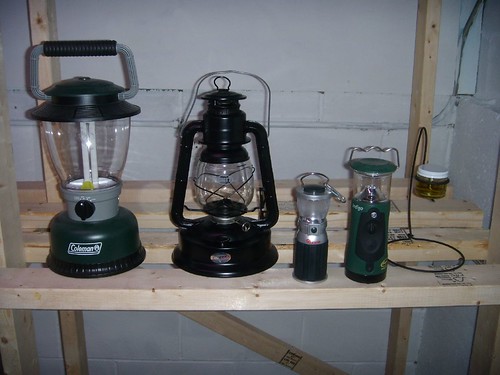
Left to right: Coleman rechargeable fluorescent lantern, Dietz "Li'l Hurricane" oil lamp, Wind-n-Go 7800, Indigo Freeplay lantern, olive oil "camp lantern"
- The Coleman lamp is by far the brightest – and by far the least pleasant light. The rest, in order of brightness, are the Dietz lantern, the Indigo Freeplay, the Wind-n-Go, and the olive oil lamp.
- LED light is harsh and blue, and throws a lot of shadows.
- Hand-crank lanterns throw about as much light as a run-of-the-mill flashlight. I’ve been really disappointed with them over all, due to flimsiness and poor lighting performance, but the Indigo Freeplay is the best in quality and amount of light of any I’ve used. (I’ve used more than the two I’ve reviewed here – these are just the ones I’ve purchased.)
- I’ve yet to find a really good alternate fuel lamp I can read by comfortably. Part of this has to do with light positioning; reading lamps are generally above your head, casting light down, but you tend to set a lantern on a table, so the page is in the book’s own shadow. I’m planning on rigging a “lantern post” that will position a lantern over my shoulder – but there are only certain lanterns I’d trust to put at the top of a post! I don’t want hot oil spilled down my neck.
- Having a variety of lights is a good idea.
- Having a/c PLUS hand crank PLUS a solar panel would be ideal for LED lights.
Name and model: Coleman Rugged Rechargeable Full-Size Lantern with U-shaped Fluorescent Bulb (Model 2000000867)
Power source: Rechargeable battery; charge via a/c plug (household outlet) or d/c adapter (car charger)
Settings: Low, high, and nightlight. The nightlight setting is useless to see anything at all, though it might comfort someone who’s terrified of the dark. Can be left plugged in and will light up automatically if the power goes out.
Light quality: Very bright, harsh blue light. Far and away the brightest lantern of this bunch, but it throws a lot of shadows. You could easily play a board game on “low”; “high” would be enough light to cook or clean by.
Reading: You can easily read by this light, though the shadows can cause difficulties. As with all lanterns, reading would be much better if the lantern were on a stand above head-height, so the light falls the way it would fall from a reading lamp.
Pros/cons: It does require electricity, though you can charge it from household a/c, the car, or any solar array with a 12v (car-type) d/c output. Very cool when running; very safe – nothing burning.
Overall rating: **** Worth buying; practical for everyday use; can be used off-grid if you have some kind of solar charger
Name and model: Dietz “Li’l Wizard” oil hurricane lantern
Power source: Lamp oil or clarified kerosene. I’m using lamp oil.
Settings: Flame can be set from low to high; there is a very noticable difference depending on how high you turn the wick up. The lamp also gets marginally brighter after it’s been burning a few minutes. It is far brighter than the olive oil lamp or a candle, even on medium.
Light quality: Warm and cozy yellow light, like candlelight, only much brighter than one candle and the flame does not flicker at all.
Reading: If I position myself and the lamp correctly (which is not necessarily easy or comfortable), I can read by this light. Mothers around the world would shriek that I’ll go blind doing it, though. After a few minutes, I was happy to extinguish this lamp and turn the CFL reading lamp back on.
Pros/cons: The lamp kicks out a lot of heat when it’s running. That’s a big plus for the winter, but a con in the summer. If there is a hard freeze forecast and I’m worried about things in the greenhouse, I will put this lamp out there to burn overnight. In a true heating emergency, I bet it (and our body heat) would keep our small bedroom at a very reasonable temperature. I’ll test that out at some point this winter.
Lamp oil is expensive – $4.50 a quart where I have found it so far, and this lamp will hold nearly a quart. It’ll burn for 24-30 hours, about the best ratio of the Deitz lanterns (see PDF chart) I considered, but still…that’s a lot of money. Kerosene is cheaper but smellier. You can use either, so long as you swap the wick and clean the fuel chamber in between. You cannot use any kind of vegetable oil.
This is probably the safest flame-based light there is. It’s sturdy and unlikely to tip over easily. The flame is enclosed in a durable glass chimney, which is firmly attached to the lantern. It’s advertised to go out if it is tipped over. It won’t blow out easily if used outdoors. But – it’s still a flame, and the metal fittings can get hot in places. It does smell a bit like burning oil, especially in the first few uses. Lamp oil is safer than kerosene for indoor burning, but hurricane lanterns like this can safely burn clarified kerosene indoors. (Even better for using kerosene – which is much cheaper than lamp oil – indoors is a “hot blast” lantern, but they supposedly throw half as much light.)
Overall rating: *** Good light, but not my first choice for everyday…unless it’s cold. Ok for off-grid if you can get lamp oil or kerosene
Name and model: Wind-n-Go LED lantern model 7800
Power source: Hand crank only
Settings: On/off
Light quality: Cold, bluish, LED light. Many shadows. I found a tip online suggesting you could diffuse the harsh light by wrapping the globe with Scotch tape. I did that on this lamp, and it really does help soften the shadows. It’s ugly, though.
Reading: If you’re desperate…at least you can hold it right next to your book without setting it on fire.
Pros: No outside fuel source needed. Cheap. Would give you light to find the matches to light an oil lantern. Safe. Cons: Feels quite flimsy compared to the Freeplay. Winding is a chore; I wish it also had an a/c plug so I could keep it charged when there is a working outlet nearby.
Overall rating: ** Not a total piece of junk, but its uses are very limited and I’m not convinced it’s study enough to last long
Name and model: Freeplay LED lantern. Newer model is available here. Looks to be pretty similar, though I swear I didn’t pay $55 for mine. Wonder if this one has upgrades?
Power source: a/c plug or built-in hand crank
Settings: Dimmer switch for main LEDs; also a one-LED spotlight that’s good for reading or other spot-illumination tasks.
Light quality: Cold, bright, bluish LED light. Though it’s hard to tell in the pictures, it does put out more light than the Wind-n-Go. The spotlight is incredibly handy; I probably use that more than the lantern part. The top of the lantern is a curved reflector that gets more of the light pointing down where you need it, too. Like most multi-LED lights, the lantern part casts a different set of shadows with each bulb (5 total). Since the globe isn’t frosted, this can be really obnoxious. Frosting the bulb with tape is an option; I wish the globe just came frosted, though.
Reading: Not bad with the spotlight. I’ll turn the spotlight on and tucking the lantern under my arm, so the light points directly at my book, and it’s not too bad.
Pros/cons:Very sturdy hand-crank – the best of any crank-powered light I’ve tried. (The one on my solar/crank flashlight/weather radio broke off on the first serious winding, and the Wind-n-Go feels pretty flimsy, too.) A decent amount of light, especially for a hand-crank light. The a/c charging option is very convenient.
Overall rating: **** Of the hand-crank lights I’ve bought, this is the only one I’d buy again. It won’t do for a room light, but I use this the most when the power goes out.
Name and model: Olive oil cabin lamp
Power source: Olive or any other vegetable oil. You can even use animal fat in a pinch. Do NOT use any petroleum-based oils.
Settings: On/off
Light quality: Warm and yellow, like a candle, but does not flicker at all.
Reading: Not really. Perhaps if it were positioned differently…but it’s too shaky on its stand for me to trust it above my head.
Pros: The only lamp I could grow fuel for. Non-flickering light is nicer than a candle, and a bit brighter. When using olive oil, it’s smokeless and nearly scentless. (The smell just makes me think something’s cooking.) Cons: Very concerned that it could tip over. Not bright enough for seeing many details (it’s far less bright than the Deitz) and doesn’t throw light terribly far. Olive oil is expensive, but you could use cheap pomace olive oil – which would definitely be cheaper than lamp oil. I haven’t tried it with sunflower oil yet, but I’ll do that when I get around to pressing some.
Overall rating: *** Pleasant ambient light; the most truly sustainable light in the bunch since you can grow the fuel. Could easily be improvised at home (jar + wick + wire wick holder). A good lesson in the need to change expectations for light off the grid.

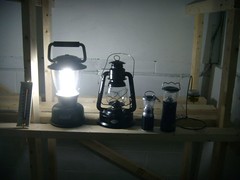
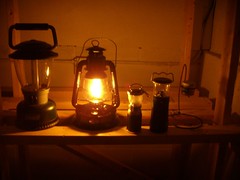
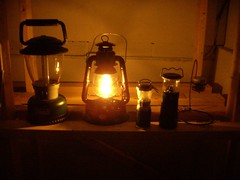

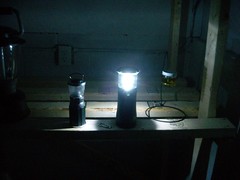
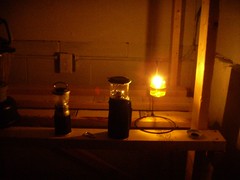
No comments:
Post a Comment